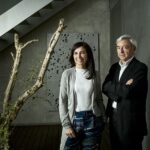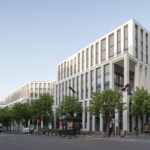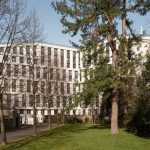Louvre Museum Visconti Courtyard Building Photos, Islamic Arts Wing Paris Design, Architect
Louvre Museum Visconti Courtyard
Islamic Arts Wing, Paris, France, design by Architects Rudy Ricciotti / Mario Bellini
21 Sep 2012
Musée du Louvre – Pyramide, Paris Ie
New Islamic Arts Wing
Location: Paris Ie, France
Design: Architects Rudy Ricciotti and Mario Bellini
Lafarge Concrete Is The Perfect Match For Architectural Daring At The Louvre Museum In Paris, France
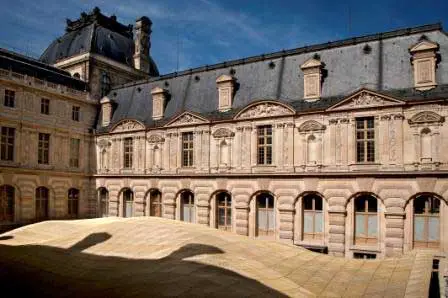
photograph © R. Ricciotti – M. Bellini/Musée du Louvre © Lisa Ricciotti
Louvre Museum Visconti Courtyard – Islamic Arts Wing
A new cutting-edge architectural structure is to open to the public after five years of construction work; designed to showcase the museum’s treasures of Islamic art, the new project is located in the Visconti courtyard, at the very centre of the Louvre. Lafarge has worked in close partnership with the architects to supply the most appropriate materials for the structure, hailed as the most significant museum expansion project since the Louvre’s great Pyramid.
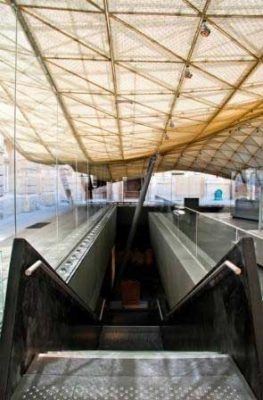
photograph © R. Ricciotti – M. Bellini/Musée du Louvre © Lisa Ricciotti
Lafarge’s CEO Mr Bruno Lafont comments:
“We are delighted to be involved in the new Islamic Arts wing; the wealth and diversity of culture in the treasures it showcases are a perfect reflection of Lafarge values. Architects Rudy Ricciotti and Mario Bellini have succeeded in creating a contemporary structure which enhances the cultural heritage surrounding it.
The new wing is a genuine architectural feat, owed to the innovative use of concrete. The staircase which links the two exhibition levels, constructed in a single pouring of black concrete, is a particular achievement, both from an artistic and a technical point of view. “
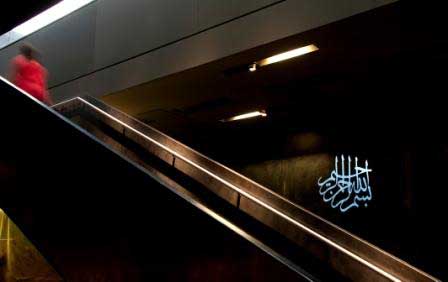
photo © R. Ricciotti – M. Bellini/Musée du Louvre © Lisa Ricciotti
Concrete as the Material of choice, for its structural and aethetic qualities
Concrete has been used throughout this project, in perfect harmony with the stone of the Louvre.
· All walls are entirely coated in a 6cm deep Agilia® black concrete facing, thus adding depth to the space and providing a better backdrop for the collection.
· Also in black concrete is the monumental 16 metre long staircase linking the lower ground and ground floor levels. As well as enhancing the smooth flow of the space, the monolithic staircase is a work of art in itself. Its construction presented a technical challenge: the selfplacing qualities of Lafarge Agilia® concrete enabled it to be injected from the base in one single pouring.
· Agilia® was also used for the 12 columns supporting the floor.
· Ductal®, Lafarge’s ultra-high performance fibre-reinforced concrete, was the material of choice for the staircase steps and risers to provide added resistance (6 to 8 times more resistant than traditional concrete).
· Ductal® was also used in the manufacture of the frame supporting the Mamluk Porch, one of the major pieces of the collection, and in the corridors which link the new space to the museum are other galleries.
Lafarge has enjoyed a close partnership with the Louvre for over 15 years and is a patron of this new wing.
KEY FIGURES
– 16 months on site
– 5800 m3 of concrete supplied
– a staircase 16 m long and 13 m³ in volume
– 128 m³ of inner walls in black Agilia® concrete (equivalent to 2 140 m²)
The Louvre Pyramid:
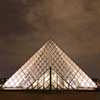
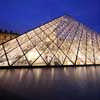
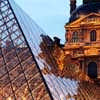
images © Steven Powell, 2010
GENERAL INFORMATION
Lafarge is a world leader in building materials and its core businesses of Cement, Aggregates and Concrete hold top ranking positions in their respective markets. Through its network of 68 000 employees across 64 countries Lafarge is deeply committed to wider local cultural involvement.
The company invests in iconic projects at the heart of its activities, such as the renovation of the ancient Erbil Citadel in Iraq, or the restoration of Eileen Gray’s Villa in the South of France. Through its close association with the national Fondation du Patrimoine, the Group has also contributed to the safeguarding and rehabilitation of France’s unprotected rural heritage (including churches, towers, communal wash houses etc.).
Since 1995, Lafarge has been actively engaged in scientific collaboration with the Louvre, through the work its research centre carries out on materials for the benefit of heritage restoration. In the 90s, the research centre thus created an exceptionally resistant material similar to gypseous alabaster in order to create a reproduction of an Assyrian winged bull from Khorsabad housed in Chicago, which is currently on show in the Louvre.
Supported by its world leading research centre on construction materials, Lafarge focuses on innovation across its activities for the benefit of sustainable construction and architectural creativity.
Further information on the Lafarge Group and its activities is available on its website: www.lafarge.com
Louvre Museum Visconti Courtyard : Islamic Arts Wing, Paris images / information received 210912
Rudy Ricciotti Exhibition, Cite de l’architecture Show
‘Architecture is a combat sport’ – architectural article by Rebecca Breun, e-architect

photo © RB
Rudy Ricciotti Exhibition Paris – 16 Apr 2013
There can be no question about it: Rudy Ricciotti is the French architect to watch at present.
Islam Arts Department Louvre Museum, Paris – new information + photos – 29 Aug 2013
Design: Architects Rudy Ricciotti and Mario Bellini
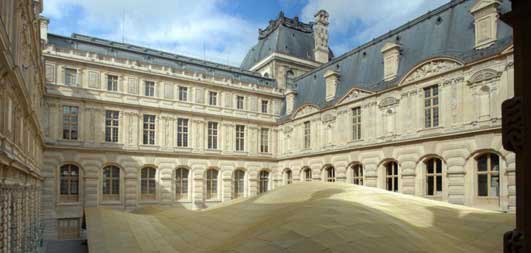
photograph : Raffaele Cipolletta
The idea of covering the Cour Visconti with a glass roof would hark back to a nineteenth-century concept for a space that, until today, has looked at the sky. We proposed the creation of a sail-like glass and metal canopy set back from the historic facades on all sides, floating over the galleries like golden, iridescent cloud that filters daylight.
Location: Musée du Louvre, Paris, France
New Paris Architecture
Contemporary Paris Architecture
Paris Architecture Design – chronological list
Architecture Tours Paris by e-architect
Louvre Museum Pyramid
Musée du Louvre – Pyramide, Paris Ie
Architect : I.M. Pei & Partners (Pei Cobb Freed & Partners), Architects
The Louvre Pyramid design by IM Pei was one of the most controversial of President Mitterrands´ Grand Projets in Paris:
Entitled Le Grand Louvre, the design completed in 1981 involved a glass pyramid central to the courtyard allowing better access and circulation into these famous Parisian galleries.
Louvre Museum Pyramid designer : IM Pei Architect
Musée du Louvre / The Louvre Museum, Paris Ie
Design: various architects
Louvre Pyramid architect : Ian Ritchie
C42 – Citroën display building
Manuelle Gautrand architect
C42 Citroen Paris
Design: Dietmar Feichtinger Architectes together with Celnikier & Grabli Architectes
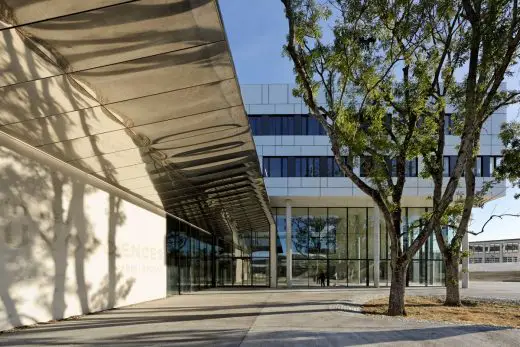
photo © David Boureau
Campus CEA Paris-Saclay Neuroscience Institute
Design: Dietmar Feichtinger Architectes
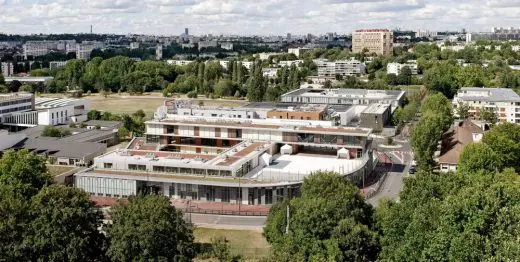
photo © David Boureau
Groupe Scolaire Dunoyer de Segonzac, Antony
Docks de Paris, Cité de la mode et du design
Jakob+MacFarlane architects
Cité de la mode et du design Paris
Louvre Museum Pyramid Building
Comments / photos for the Louvre Museum Visconti Courtyard – Islamic Arts Wing Paris page welcome


